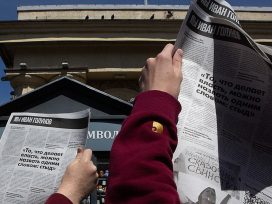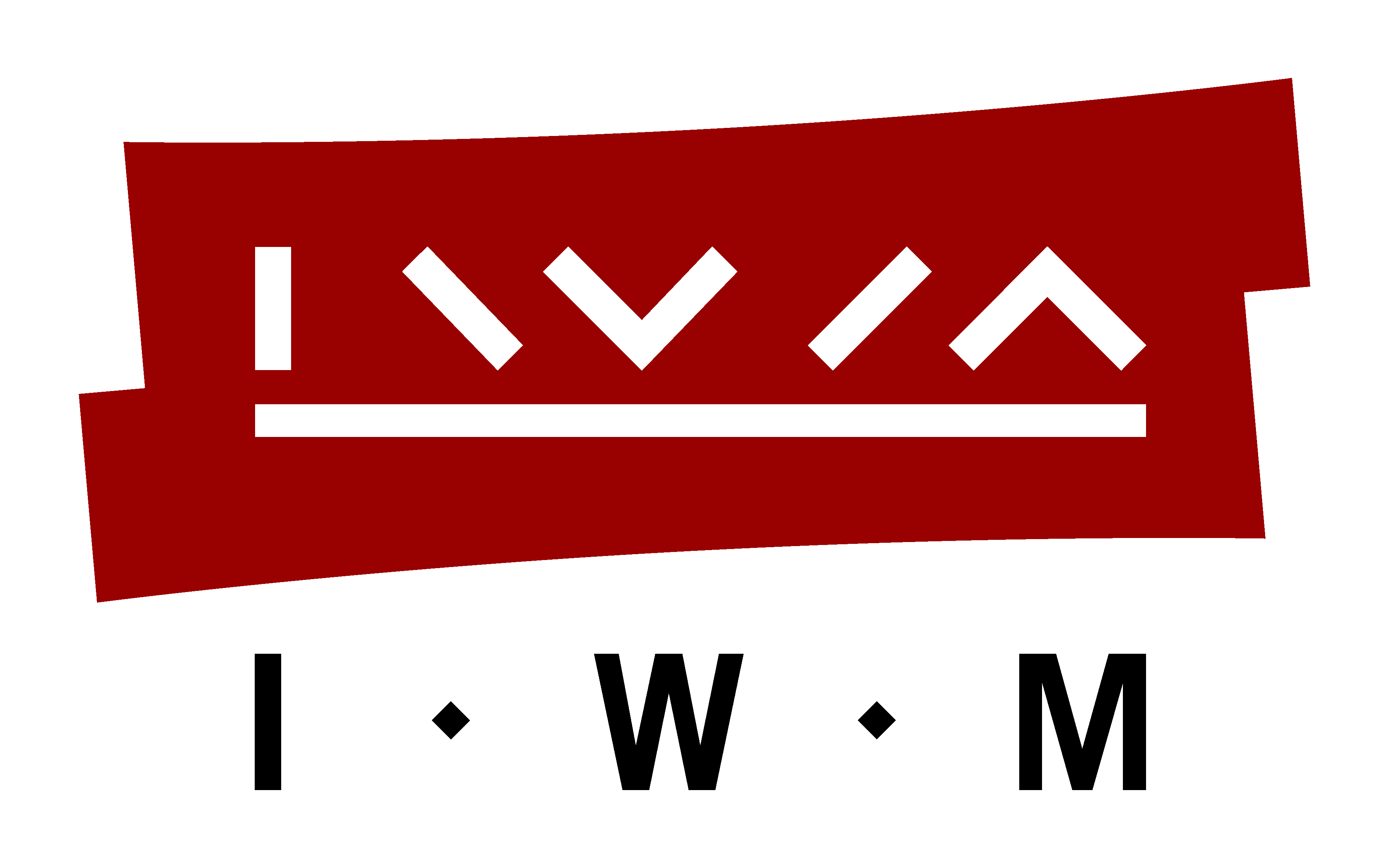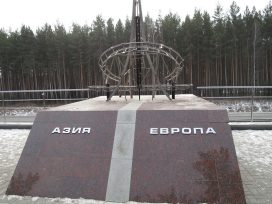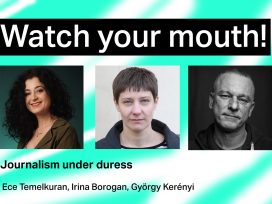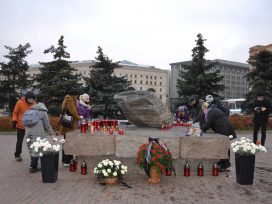On coming to power, Vladimir Putin set about restricting the freedoms that Russian media enjoyed under Yeltsin. After the protests of 2011–12, even the smaller-audience media that still pursued editorial independence came under pressure. Recently, a rise in civic activism and the rapid expansion of internet technologies have brought a new vibrancy – although non-government media remain powerless before the Kremlin’s political monopoly.
The political and economic reforms introduced after the collapse of communism radically changed the Russian media landscape. In the words of the journalist Natalia Timakova, ‘the ideal example of interaction with the press was under Boris Nikolayevich Yeltsin, who generally did not believe in settling scores with journalists’.1 Timakova was in a unique position to observe Russian politics and the relation between power and the media. In the 1990s, she was a member of the journalists’ pool covering President Yeltsin. At the end of the decade, she and two colleagues spent many hours in conversation with Vladimir Putin, just before he became president of Russia.2 She served as Dmitry Medvedev’s press secretary throughout his presidency and, then from 2012 until 2018 in his capacity of prime-minister.
Many journalists who worked in the Russian media in the early post-Soviet period would probably agree with Timakova. The period was marked by a surge of idealism and enthusiasm, as Russian reporters and editors embarked on building new, post-communist media. Yet an outright positive assessment of the Russian media scene of 1990s is hardly appropriate. Looking back, critics have pointed to emerging media tycoons’ use of their outlets to further their political and business interests, or to the ‘incestuous’ relationship between business (media owners being no exception) and government.3 Yeltsin’s 1996 re-election campaign was a closely coordinated effort between members of the Kremlin administration and a group of Russia’s wealthiest business magnates, commonly referred to as ‘oligarchs’. The ‘oligarchic media’ played a key role in that effort. After Yeltsin’s re-election, the ‘oligarchs’ engaged in fierce rivalry over the spoils and used their media resources as weapons in the struggle.
Yet, throughout the 1990s, the Russian press remained unconstrained by the state – a fact whose significance cannot be overestimated, given the decades of Soviet censorship, when not a word could be broadcasted or printed without prior approval by a communist censor. If the media environment of the 1990s did not meet high democratic or ethical principles, at least private ownership and absence of government-imposed constraints ensured pluralism of coverage and opinion.
Among the most important media projects launched in the early 1990s was Kommersant, a high-quality business and political daily, and NTV, a national TV channel founded by the magnate Vladimir Gusinsky. NTV earned its credentials as a serious and influential news organization when, very soon after its launch, its young reporters provided critical coverage of the first Chechen war (1994–1996). Every day, horrific scenes from Chechnya appeared on television screens in Russian homes and generated broad anti-war sentiments, forcing Yeltsin to initiate a peace process. In its level of post-Soviet professionalism, quality and style, NTV far surpassed its rival state channels.
Putin’s first term
When Vladimir Putin became Russian president in 2000, his primary goal was to reassert the power of the state. From the beginning, all political power was steadily concentrated at the top of the executive branch – regional governors, political parties, and the federal legislature soon found themselves under state control. Putin soon evolved into Russia’s uncontested and unchallenged leader.
By the end of Yeltsin’s tenure, the state controlled only one national TV company: VGTRK. After becoming president, Putin and his administration moved to take control of the other two major national TV channels – Gusinsky’s NTV and ORT/Ostankino (today’s Channel One), a former Soviet, state-owned channel. After the collapse of the Soviet Union, Boris Berezovsky, another major business tycoon, acquired part ownership and de facto control of ORT.
Within two or three years, using different lines of attack, but without directly resorting to violence, the Kremlin got rid of both media oligarchs, who were stripped of their media assets and forced to leave Russia.4 Gusinsky’s NTV was taken over by Gazprom-media, the media subsidiary of the state-controlled giant Gazprom. The government did not harass or prosecute NTV journalists; it effectively framed the NTV takeover as a business dispute between Gazprom and Gusinsky. This was clever, since people could hardly be expected to sympathize with a ‘fat cat’ in trouble with the government. The ownership structure of ORT was more complicated, but eventually it also came under the state control. ‘Oligarchic TV’ thus ceased to exist.
Redistribution of media assets to loyal owners has remained the Kremlin’s instrument of choice for ensuring control over the media, without resorting to the outright repression of journalists or editors. In the early stages, national TV channels were the primary target. Over time, however, these tactics have repeatedly been used on other media.
As the Kremlin and its allies tightened control over national television, editorial policy also fell into line. Before the end of Putin’s first term, all three federal TV channels, whose outreach far surpassed all other Russian media, had been turned into the Kremlin’s political tools. Putin became a daily presence. National TV projected the image of Putin as firmly in charge – a guarantor of social and political stability and the country’s ultimate problem solver – and destroyed faith in any alternative. During federal election campaigns, TV sought to win over voters to the pro-Kremlin United Russia party. At other times, coverage had narrower aims: to boost, to play down, or to ignore events so as best to suit the Kremlin’s political interests, or to discredit individuals and groups.
The Kremlin’s TV management relied on co-option, not compulsion. The three top TV managers – Oleg Dobrodeev of VGTRK, Konstantin Ernst of Pervy kanal, and Vladimir Kulistikov of NTV – were entrusted with the task of shaping public opinion in the Kremlin’s interests and evolved as its eager and efficient associates. In the words of Svetlana Mironyuk, the former top manager of the government news agency RIA Novosti: ‘There has never been any … direct intimidation of editors and owners. [They did it] themselves.’5
Institutional decline, industrial rise
During the 2000s, the rise of oil prices brought about significant economic growth. This also affected the media. One important consequence was the rapid growth of the advertising market. The media industry, especially TV, was growing. TV companies were expanding to include film and series production, as well as other activities. They mastered new formats and technologies and honed their business operations. Competition for advertising revenues was fierce, unfolding first and foremost around entertainment programming.
The switch to entertainment programming was an important consequence of economic growth. As the turmoil of the 1990s gave way to stability and relative prosperity, the Russian population became more quiescent. In 2003, the Russian news magazine Kompania wrote: ‘On the whole, Russian TV has become about entertainment. From a business perspective that’s justified, since the TV companies have begun to draw profit. From the standpoint of the public good, that’s questionable: electronic media will no longer be able to control the government’s performance.’6 The rise of the media as an industry was thus accompanied by its institutional decline, as tight state control stripped media of their watchdog function.
Although Putin’s government took pride in ridding Russia of its ‘oligarchic media’, the media assets amassed during Putin’s own tenure were enormous, substantially exceeding those of Gusinsky or Berezovsky in the 1990s. Loyalty to the president became the order of the day – big business in general, and media holders in particular, pledged full allegiance to the man in the Kremlin.
Some of the media with the largest audiences were entrusted to magnates who had made their fortunes in the 2000s in the energy sector or banking. By the end of that decade, National Media Group (NMG) – controlled by business structures associated with Yuri Kovalchuk, broadly reported to be a member of Putin’s inner circle of old friends – included two national media channels with news coverage (REN TV and Channel Five) and an entire range of other TV, print and online assets.7 In early 2011, NMG vastly increased its holdings by purchasing a twenty per cent share in Channel One.8 In 2016, the value of NMG was estimated at 150 billion roubles ($2.2 billion).9 In addition to media outlets, Kovalchuk’s Bank Rossia bought a share in Russia’s largest advertising sales house VI.10
By the end of Putin’s first two terms, huge media holdings (including nearly all of the two dozen federal TV channels, some with news coverage, some purely entertainment) were concentrated in the hands of just three entities: the state itself; Gazprom-Media and NMG. In 2006 Alisher Usmanov,11 whose major business was in metals, purchased the publishing house Kommersant. Usmanov has since become one of the top ten wealthiest Russian magnates. His assets include stakes in telecom, media and Internet companies, but his largest holding remains his stake in the iron ore and steel giant Metalloinvest.
It should be pointed out, however, that the structure of media property is opaque. Major media interests are closely intertwined; redistribution of stakes among them, or to trusted proxies, is not uncommon and mostly hidden from the public eye. It is therefore hard to say with certainty where Gazprom media property ends and that of NMG begins. One thing is clear, though. However they are distributed, important media assets ended up securely under the control of trusted loyalists.
In the 2000s, on the margins of the Kremlin-controlled media, niches of free expression continued to exist in print, radio, smaller-scale TV and, later in the decade, online. However, because competitive politics had been eliminated, and checks and balances emasculated, alternative media became politically irrelevant with no effect on policy making. The Kremlin, therefore, could afford to be permissive. As Putin gained the support of the overwhelming majority of Russians, the audience of non-government media outlets remained relatively small and they mostly preached to the converted.
Medvedev’s verbal liberties and the protests of 2011–12
In 2008, Putin stepped down and anointed close associate Dmitry Medvedev as his successor. Although Putin, now as prime minister, remained Russia’s most powerful political figure, Medvedev’s presidency still made some difference. Medvedev was younger, he did not have a KGB past and introduced liberal rhetoric to the Russian political scene. The phrase ‘political thaw’ entered the jargon of the early period of the Putin-Medvedev ‘tandem rule’.
While national television channels continued to be the political resource of the Kremlin alone, the new permissiveness unleashed more daring criticism in the non-government media. Some of the previously non-political media became politicized. This applied, in particular, to the ‘hipster press’. For instance, Bolshoi Gorod (Big City), a bi-weekly magazine about Moscow city life, and Afisha (Billboard) magazine, both of whom had originally focused on culture and leisure, now developed defiant political voices. New media outlets also emerged. They included TV Dozhd (TVRain), a small operation launched in 2010 by the mid-level entrepreneur Alexander Vinokurov and his wife Natalia Sindeeva, an almost unique example of private business openly funding a TV outlet that asserted editorial independence. TVRain substantially broadened its outreach after it was included in cable packages.
The newly energized non-government media sector was filled with reportage and critical policy analysis as well as angry opinions and poisonous jokes. The tandem period was also marked by rapidly growing internet penetration. Most major print and radio outlets developed online platforms, some of which combined text, audio and video content. Advanced users of liberal leaning in greater numbers switched to Facebook, where they exchanged references to media publications and engaged in discussions.
The rise of the web generated a ‘digital divide’, with more sophisticated users often being more critically minded. The internet was awash with reports, both by professional journalists and ordinary citizens, on lawlessness, injustice and abuse by government or police authority. The number of bloggers increased, some becoming voices of authority for tens of thousands of followers. The popularity of social networks facilitated the exchange of information and social linkages. Civic activism was on the rise. Then Putin announced that he was returning to the presidency.
Putin’s crackdown and the surge of anti-Maidan propaganda
A shift towards a more authoritarian policy was triggered by the mass street protests in December 2011, continuing into 2012. Outrage over the ‘castling’ trick – with Putin and Medvedev announcing that Putin would be running for president in 2012 while Medvedev would assume the office of Prime Minister – was exacerbated by egregious rigging during the December 2011 parliamentary elections. Protest rallies broke out in Moscow, peaking at one hundred thousand participants, and in other large cities. The internet and social networks proved excellent tools for organizing rallies and disseminating information among the protest community. The ‘hipster press’ provided enthusiastic coverage; its journalists were at the very centre of the protests.
After Putin’s inauguration in May 2012, the Kremlin went on a counteroffensive against the newly politicized and non-compliant Russian citizenry. State-controlled television launched a smear campaign against anti-Putin activists and journalists, with terms such as ‘national traitors’ and ‘fifth column’ entering the language of news programmes and talk shows. Around the same time, non-government media started coming under pressure. The redistribution of media assets carried out earlier greatly facilitated the Kremlin’s task: loyal business tycoons could be relied on to dismiss audacious editors and authors and de-fang their outlets’ editorial policies. This spared the Kremlin the trouble of direct interference with media operations, harassment, or persecution of individual journalists.
Beginning in late 2011, a few leading editors lost their jobs this way – whether fired or forced to resign by the owner. In December 2011, the editor-in-chief of Vlast’, the Kommersant weekly magazine (owned by Usmanov), was forced to resign after publishing a photograph of a voting ballot with an expletive directed at Putin.12 Kommersant daily, until then a high-quality mainstream publication, lost several prominent journalists, grew tamer and fell below its former editorial standards.
One of major blows to the media realm was the radical reformatting, in late 2013, of the Russian state news agency RIA-Novosti, a decision taken by Putin personally.13 The head of RIA-Novosti, Svetlana Mironyuk – a highly professional and respected media manager – was replaced by Dmitry Kiselev, a TV host known for raving on air at anyone whom the Kremlin regarded as an enemy of Russia: Ukrainian politicians, homosexuals, Americans, and so on.
One month after RIA-Novosti, TV Rain came under pressure. Under the pretext of an unethical question to viewers posted on its website, all cable operators successively terminated their contracts with the channel. There is every reason to believe that the operators were directed to do so by somebody ‘up top’. TV Rain was forced to switch to online distribution and lost around ninety per cent of its audience overnight.14
The next to come under attack was Galina Timchenko, the editor-in-chief of Lenta.ru, a political website owned by billionaire Alexander Mamut, a major owner of Internet media. Under Timchenko’s editorship, Lenta.ru had become a politically audacious outlet, a must-read for anyone interested in high-quality news coverage. Mamut fired Timchenko, after which almost all members of her team resigned in protest.
In 2014 Pavel Durov, the founder of VKontakte, Russia’s biggest social network (used by eighty per cent of Russians aged 18–24), was pressured to sell the company to a partner of Usmanov, and subsequently left Russia.15 In 2016, three top editors at the media holding RBC (owned by billionaire Mikhail Prokhorov) were dismissed or forced to resign after publishing reports and investigations on politically sensitive subjects. In 2017, Prokhorov then sold his troublesome media asset to energy tycoon Grigory Berezkin, a staunch Kremlin loyalist.16
When the war broke out in Donbas after the annexation of Crimea in 2014, Russian national television launched an intense propaganda campaign. Mass-audience TV channels descended on Ukrainian ‘fascists’ and their western ‘masters’. News programmes began lasting much longer than usual and became almost entirely focused on Ukraine, with only a small fraction of airtime devoted to Russia proper. The propaganda onslaught boosted Russian nationalism even further in the wake of the ‘rally-around-the-leader’ effect generated by the annexation of Crimea. Putin’s approval rating, which had dropped to just over sixty per cent before his return to the Kremlin, jumped to over eighty per cent after the annexation of Crimea. It remained at this level through his re-election in 2018 (though it later dropped again and has since hovered between 60 and 70 percent).
The shrill propaganda on TV news programmes was toned down from mid-2015. The Kremlin appeared to revert to its more habitual demobilization policy, although aggressive anti-western rhetoric and denunciation of anyone deemed a national ‘enemy’ remained the signature style of the two highly popular political ‘talk-shows’ on the Rossiya channel (part of VGTRK).
TV versus the internet
The constituency of TV viewers is slowly decreasing. According to the Levada Centre, Russia’s largest independent polling agency, seventy-two per cent of people cited TV as their most frequently used source of news in 2019, down from ninety-four per cent in 2009.17 The youngest generation of Russians, however, tend to get their news from online sources, particularly social networks (just forty-two per cent cited TV as their source of news). Overall, the national TV audience still exceeds that of any other source – watching TV remains habitual, easy and free. At the same time, trust in TV has steadily declined from eighty per cent a decade ago to about fifty per cent today.
In the summer of 2019, the blatantly unfair disqualification of independent candidates from the Moscow city council campaign provoked another wave of mass protests that were brutally suppressed. A survey conducted shortly after showed decreasing common ground between young and old, between online users versus TV watchers, and between ‘critics’ vs ‘loyalists’.18 The former sympathized with the protesters, while the latter were more likely to disapprove of them and to believe that they had been incited by the West or other ‘provocateurs’ (the interpretation offered by state TV). The report suggested that, in the future, the gap between those groups would widen and their opinions of political and social developments would diverge even more.
The ‘digital divide’ between Internet users and TV viewers that emerged in the late 2000s grew less noticeable after the annexation of Crimea and the consequent upsurge of national enthusiasm. These days, however, the ‘Crimea effect’ has largely worn off, and the divide is back. The coming-of-age of an innately tech-savvy generation, and the rapid development of multiple online communications including YouTube, Telegram (messaging) channels, video blogs and social networks have contributed significantly to this polarization. State TV may fill the airwaves with ‘correct’ content, denouncing the protesters and portraying them as playthings of the West, but with thousands of photos and videos of police brutality instantly available in social networks, the government’s capacity to shape public opinion is limited.
While access to non-governmental sources of information is an important factor, one should not overrate its impact on society at large. The Kremlin may no longer have a monopoly on information, but it compensates for this weakness with greater police violence and incarceration of political opponents. Russian society is developing civil society skills and people are learning to stand up to their rights, but the government’s policy of repressing a few in order to intimidate many others is still effective. Socio-economic protests have become more frequent, but political rallies like the recent Moscow protests are virtually non-existent: tight state control over the political process, and non-competitive and fraudulent elections are generally accepted as facts of life.
Internet under pressure
In response to the mass protests of 2011–12, the Kremlin hardened its policy towards oppositionist activism and launched a crackdown on the internet. The government has recently made substantial progress in imposing legal, technological and other constraints on the Web. This effort is focused less on Chinese-style restriction of access to information, and more on undermining people’s capacity for political organization. The Kremlin does not mind people ‘knowing’, but this ‘knowledge’ must not undermine the stability which the Kremlin equates with its own political dominance.
Government measures are focused on surveillance, in particular, forcing Internet providers to share users’ personal data. In a striking example in 2018, a court banned the encrypted messaging app Telegram after its developers refused to provide the Federal Security Service (FSB) with encryption keys that would give it access to users’ communications. Telegram, which has more than 200 million users worldwide, was created by Pavel Durov, who had earlier been forced to sell VKontakte. The campaign to block the app inflicted much ‘collateral damage’, but because of Telegram’s sophisticated design, failed to close it down.19
A recent major step aimed at controlling the Internet was made in spring 2019, when a bill on the ‘sovereign Internet’ was passed giving the authorities the power to unplug the national internet network from the outside world.20 The government’s rationale for this new measure is the need to defend Russia in case the United States were to cut Russia off from the global Internet. Critics warned that this new piece of legislation would facilitate government censorship of the Internet. A few months after the bill’s adoption, however, some experts claimed that its implementation was technically unfeasible, at least for now.21
In today’s Russia, those who dare to organize or join political rallies, or even individual pickets, are beaten, detained and prosecuted. Aleksey Navalny, Russia’s most prominent political activist, has repeatedly been harassed, assaulted and arrested on various charges; he spent 120 days under administrative arrest in 2017–2018 alone. The police operation against the summer 2019 protests was more brutal than usual. Several participants were sentenced to long jail terms in hasty hearings broadly deemed unfair and politically motivated (thirty-eight per cent Russians said so in a recent poll22) ; a few others await trials.23
In the media sector, however, the Kremlin still refrains from direct harassment or prosecution of journalists. Instead, alongside relying on media owners’ cooperation, the government prefers tools such as economic suffocation: by levying gigantic fines or stripping outlets of advertising revenues (as with TV Rain).24 Either because the Kremlin realizes that it needs to allow the opposition to let off steam, or for some other reason, it is still not out to destroy every non-government media outlet. At the same time, the readership of the ‘traditional’ press has radically shrunk. According to Levada Centre report in 2017, a mere five per cent of the population read newspapers daily or almost daily, down from 64 per cent in 1990.25
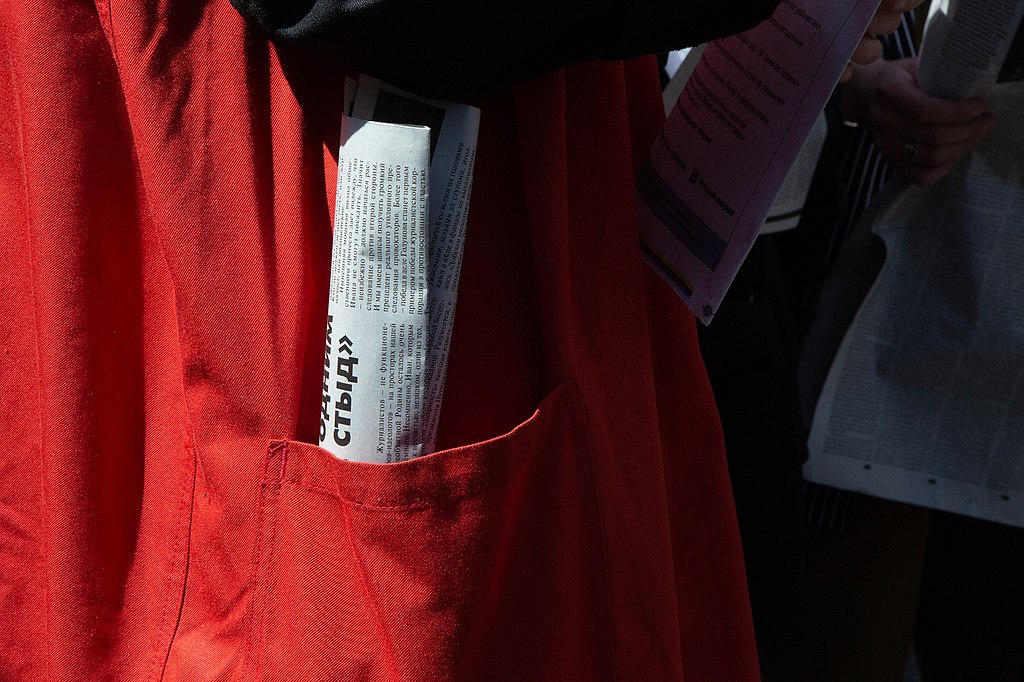
Ivan Golunov support meeting on Vosstania Square, St. Petersburg. Photo by Leonid Ryzhik from Wikimedia Commons
Russian media is not dead
Political decision-making has long become fully opaque and is now the object of speculation rather than reporting. But high-quality reportage on a broad range of important and often sensitive subjects, such as corruption and the abuse of authority, police brutality and torture, or unlawful prosecution, is covered daily by alternative sources. These include some of the ‘old’ media and a range of new ones using modern communications formats. Investigative reporting appears to be on the rise. The pool of non-governmental information is vast and easily available for the limited constituencies that are interested in it. As experts from the Levada Centre point out, to be truly critically-minded, one has to use several nongovernment sources of information; this constituency amounts to 16 per cent in Moscow and 6 per cent nationally.26
To name just a few examples: Novaya Gazeta, long famed for covering the most dangerous topics, remains as daring as ever. For instance, in its recent investigations include the deadly persecution of homosexuals in Chechnya.27 It has also covered mysterious assassinations and poisonings linked to ‘Putin’s chef’ Yevgeny Prigozhin.28 Alternative, non-government media projects are not limited to Moscow. A good example is 7х7 – Horizonal Russia, a news and opinion website founded in the Komi Republic in 2010, now with branches in a number of medium-sized Russian cities. 7×7 describes itself as a ‘territory free from the state. An independent project that seeks … to engage in cooperation all living forces of the civil society’.29
A recently established private media award Redkollegia aims at supporting those ‘who still pursue high professional standards in Russia at the time when free and high-quality journalism finds itself under the government pressure’.30 Apparently, the Redkollegia board has a large pool to choose from, as they award at least two or three journalists every month.Sergey Parkhomenko, a Redkollegia board member, wrote in September 2019 that good materials submitted in recent months had been ‘too many to choose from’. ‘Those who still believe that Russian journalism is dead, should visit the Redkollegia Website … they will be cured of this delusion.’31
Further examples of non-government media include Republic.ru, which describes itself as a ‘community of editors and authors’ covering the most important developments in Russia and the world, including in health, science and history. Colta.ru, meanwhile, is a high-quality, intellectual source on culture, art, science and society. High-quality online ‘émigré’ publications have also been launched in recent years by editors forced out of their jobs in Russia. Galina Timchenko, the former editor of lenta.ru, founded meduza.io together with her former staffers; the online publication operates from Latvia. Yelizaveta Osetinskaya, the former head of RBC, launched thebell.io; it operates from the US and focuses on business news and commentary. Though managed from and hosted abroad, both projects rely on reporters working in Russia.
TV Rain’s audience may have shrunk, but the channel continues to operate. Meanwhile, new online video channels have become extremely popular. The most successful among them was launched in 2017 on YouTube by Yuri Dud’, whose interviews with prominent Russians in politics, business, or culture have earned him six million subscribers, mostly among young Russians. In 2019 Dud’ produced two politically sensitive documentaries – one about Kolyma, the region notorious for some of the worst Gulag labour camps, and the other about the 2004 terrorist attack in Beslan32 – each of which were viewed by many millions of internet users.
Audacious investigative reporters do, however, operate on their own risk. Certain figures with political clout and special connections, if exposed by an inquisitive reporter, may settle scores brutally and with impunity. Several of Novaya Gazeta’s reporters have been assassinated or assaulted over the years. In 2019, Ivan Golunov, an investigative reporter working for meduza.io, was arrested on trumped-up charges of drug possession (in a heavy-handed operation, the police planted narcotics in his backpack). This episode had an unexpected happy end, however: a powerful public campaign ended with Golunov’s release and full exoneration.33 The Kremlin certainly bears responsibility for this atmosphere of lawlessness, but killing or assaulting journalists does not seem to be part of its policy. Journalists who have lost their jobs in recent years, or resigned after their publications had compromised their editorial independence, are not constrained, harassed or black-listed.
The internet as a medium of choice for civic activism
While the Kremlin is taking effective measures to prevent the use of Internet for political organization, it shows relative lenience toward civic activism. Charitable, self-help, educational, environmental, human rights and many other initiatives have been on the rise in recent years. For all of them, the internet is an indispensable medium, and in some cases their websites have evolved as high-quality ‘niche’ media. Some of the more prominent examples include OVD info which collects information about unlawful, politically-motivated persecutions and provides legal assistance, Takie dela (associated with a charitable initiative) and Arzamas (educational). Navalny and his FBK (Anti-Corruption Fund) have produced videos exposing corruption at high levels of government and invariably collecting millions of online viewers – even as Navalny and his associates find themselves under permanent harassment and occasional prosecution. Writing about the current Russian media landscape, Maxim Trudolyubov, one of the keenest observers of Russian society, described it as ‘increasingly vibrant’.34
Access to alternative, or non-governmental information, is therefore not difficult. One can spend long hours reading and watching online alternative media reports, analysis and opinion, or listening to lectures, podcasts and public discussions on all kinds of topics, including political ones. Anyone with an interest and a good command of foreign languages can access any foreign sources of information. Facebook has evolved as a social network of choice for educated liberals who draw on their friends’ opinions, debates, references, etc. Online communication plays an important and growing role enabling effective information exchange and civic organization, but so far, these niches of free expression have had no tangible effect on Russian politics and policymaking. Anxious to maintain its impenetrable political monopoly, the Kremlin resorts to repressive measures in response to the rise of modern communications technologies and any sign of the politicization of society.
The interviews were collected in the book First Person: An Astonishingly Frank Self-Portrait by Russia's President, Public Affairs 2000.
‘Incestuous’ was how the relations between business and media in 1990s were described by the Moscow-based Australian diplomat Glenn Waller, quoted in David Hoffman, The Oligarchs: Wealth and Power in the New Russia, New York: Public Affairs 2002, 322.
A detailed account of the rise and fall of the Russian oligarchs, with special chapters about Gusinsky and Berezovsky can be found in Hoffman, The Oligarchs.
An investigation conducted in 2014 by the Internet resource rbc.ru produced a chart illustrating the ownership structure of the NMG. Since the companies and individuals mentioned in the publication refused to comment, the authors opted for evasive phrases, such as ‘companies controlled by Yury Kovalchuk’. The investigation maintains that three other major tycoons belonging to Putin’s inner circle – the Rotenberg brothers and Gennady Timchenko, as well as Putin’s friend of many years, musician Sergei Roldugin – also have stakes in NMG. See: https://www.rbc.ru/business/17/11/2014/5468ae40cbb20f2878362373 See also: Maria Lipman, Anna Kachkaeva, Michael Poyker, Media in Russia: Between Modernization and Monopoly, in: Daniel Treisman (ed.), The New Autocracy: Information, Politics and Policy in Putin’s Russia, 159–190 (Brookings Institution Press, Washington, DC, 2018).
See: http://www.forbes.ru/ekonomika-opinion/vlast/63087-otdelno-vzyatyi-telekanal. According to one estimate, by the end of 2013 the NMG de facto controlled eleven of the largest Russian TV channels, 60 percent of the television audience, and 80 percent of the television advertisement revenues. The New Times, 2 December 2013, http://www.newtimes.ru/articles/detail/74981?sphrase_id=237051.
Bank Rossia acquired VI (formerly Video International) in 2010. See: www.vedomosti.ru/business/articles/2010/06/28/video-interneshnl-smenil-hozyaev
See: https://www.forbes.com/profile/alisher-usmanov/#1f6d132f6e73
Аccording to Natalia Sindeeva, TV Rain’s general director, at its peak TV Rain’s audience reached about 11 million cable viewers. After it had been dropped by the cable operators, its audience plummetted to under 100 thousand paid online subscribers. See: https://vc.ru/story/23281-sindeeva-interview
See: https://www.levada.ru/2019/08/01/21088/
For example, in late 2018, The New Times magazine, already struggling and forced to stop its paper edition for want of funds, was fined for an improbable 22 million rubles (roughly, 300 000 euros). See: https://www.svoboda.org/a/29570089.html
Published 18 October 2019
Original in English
First published by Osteuropa 10–12/2018 (German version); Eurozine (English version)
Contributed by Osteuropa © Maria Lipman / Osteuropa / Eurozine
PDF/PRINTPublished in
In collaboration with
In focal points
Newsletter
Subscribe to know what’s worth thinking about.
Related Articles
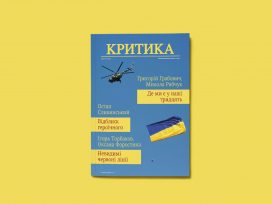
Ukraine at 30: A ‘glass half-full’
Krytyka 7–8/2021
In an issue of ‘Krytyka’ on Ukrainian independence: a catalogue of errors from Kuchma to Zelensky; a personal history of freedom formed; and seismic shifts in the Kremlin’s symbolic geography.
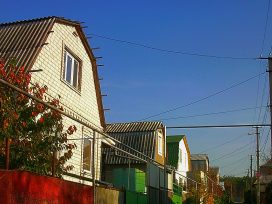
The silent colonization of Crimea
How Russia exerts control in the annexed territories
With every step taken by the Russian authorities, the reintegration of Crimea into Ukraine becomes ever more difficult. How can Ukraine claim back rights to a territory that citizens of another country de facto own?
